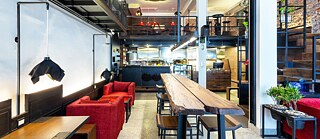Café Mango

Architecture, a state of mind, a void, a desire, a reminder, and all the other elements that we can and cannot speak of. Architecture is what we inhabit and what inhabits us. It possesses the possibility of understanding or misunderstanding its’ environment. It stands as the silent witness of a culture’s unions and ruptures. In our inner world, architecture kindles our soul and embeds us in a collective consciousness.
By Salauddin Ahmed
Café Mango and its becoming testify to that desire: with a clear intention, an honest placement, and a legible expression.
Dhaka city thrives on chaos and untold complexities. It is a geography that has been experiencing tremendous transformation in a “Still Becoming” phase of mosaics, diverse backgrounds, and all spaces in between. What animates this city: the fabric of urban sprawl tagged as “Building Production,” or the moving bodies that occupy every inch of this fabric? Whether you call it a constructed reality or an unplanned nightmare, Dhaka is weighed down far below the danger line of healthy living. At a closer look, Dhaka reveals her honest to-god-self; a “Cuckoos Nest” littered with materials from all corners of the globe without any real reason. Its round-the-clock struggle to survive, under the weight of too many people, makes one wonder how this city will reach harmony in urban living. Even in a city with over eighteen million people, we feel lonely and find no room to be alone.
But all is not lost, Dhaka still offers precious opportunities for new things and exciting ideas.
A Bangla culture, formerly known for the cultural habit of Addabaji [sharing stories], began to lose the public spaces where one could carry on such act with civility. The idea of Café Mango came in response to this absence. Unlike our youth, there are now increasingly fewer places to go to with a book to read while having a cup of tea. Nor were there occasions where one could reunite with a friend, or meet a stranger and become friends over that cup of tea. The presence of such absent places gave rise to the idea of building one of the first café-as-community in Dhaka. The name “Mango” was chosen to further support the idea. A juicy tropical fruit that comes during a long hot summer, it can be eaten raw, ripe, or even over-ripe. Almost everyone can afford to eat a mango or two while it is in season. One can say it is a fruit of love and desire, in all stages of life.
To help support the conceptual idea of this space, the design process took up the idea of etching on physical surfaces, and collaging of indigenous materials, as a way for architecture to explore the challenges and pleasures of this society, at this time. To emphasize the inherent principle of material objects and physical space, each element that was found at the original site, and any building material that was brought into the project was kept near its original state.
To help Mango visitors comprehend the inner quality of materials, the selection of materials was kept to a bare minimum. In the design, four different materials were used in their raw state: glass, steel, brick, and wood. The proportionate mix of each material was tested through collages and drawings. The usual and banal process of coating and treatment of surfaces was strictly limited, keeping new and recycled construction materials near their original state. Since the act of surface finishing is for both aesthetic and longevity reasons, we took alternative steps to slow down natural decay. Metal surfaces were treated with butcher’s wax, wooden surfaces with waterproofing and brick walls were washed and brushed clean.
To create a strong link between the interior space, garden, roof terrace, and the street, vertical and horizontal planes of wall and floor surfaces were physically cut out. In doing so, the idea of transparency was used to give each visitor the privilege of being everywhere in the cafe.
The scale and form of each seating position were designed to challenge derivative conventions, inventing a new language appropriate to this city. Tables and benches were arranged at various heights and shapes, to challenge the norm of physical distance in public space. To emphasise social gathering as a theatrical act, the main window that connects the cafe to the street is proportionate to a viewing screen. The idea is that the onlookers can look into the cafe interior, and the café visitor can look outside; thus, a temporary communion is created between the café and the city.
Finally, the café is not only a space for meeting friends, but also a quiet refuge for the solitary visitor. A rotating set of art exhibitions on the brick walls offers a chance for conversation or contemplation, around new stories and familiar tales.
Café mango stands on the idea of 'presence of absence' in this city. It refuses pretension in its design and dismisses derivative ideas in its construction. On closer examination, it reveals the honesty it possesses. Café Mango is a literal translation of carving and etching, like a printmaker on a zinc plate. In each successive layer of its design, it reveals the language of the investigation and the materials that were investigated.